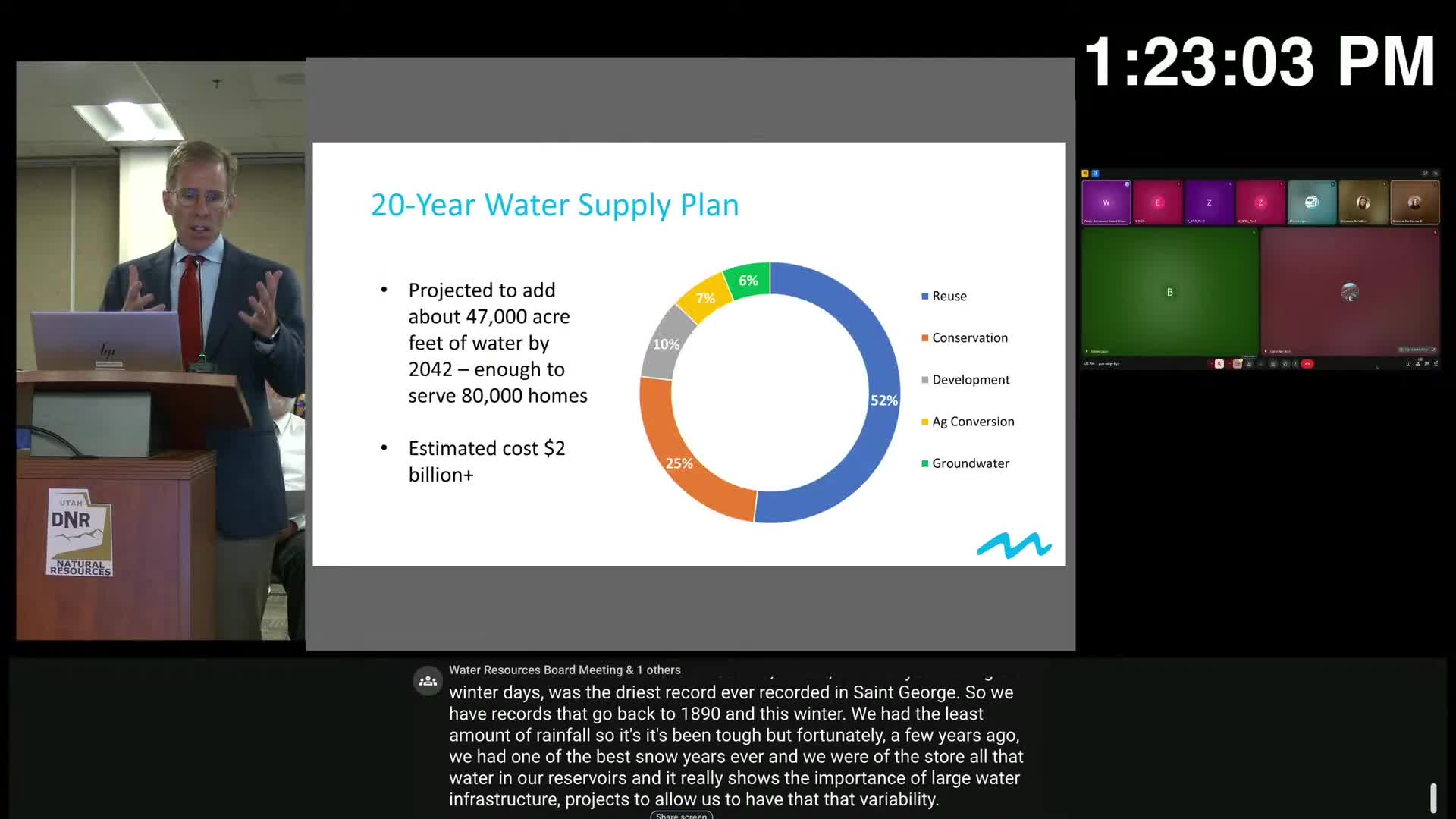Washington County unveils $1.36B water conservation and reuse infrastructure plan
June 27, 2025 | Natural Resources Department, Utah Environment, State Agencies, Organizations, Utah Executive Branch, Utah
This article was created by AI summarizing key points discussed. AI makes mistakes, so for full details and context, please refer to the video of the full meeting. Please report any errors so we can fix them. Report an error »

The Water Resources Board meeting held on June 26, 2025, focused on Washington County's ambitious 20-year water management plan, emphasizing conservation and infrastructure development. The meeting began with a presentation outlining the plan's goals, which include a significant reliance on water conservation, projected to account for 25% of future water use. The county is recognized as a leader in water conservation efforts, with initiatives such as a grass rebate program and the construction of water-efficient homes.
Key discussions revolved around the implementation of tiered water rates, which are among the most aggressive in Utah. New connections to the water system receive a monthly allocation of water, and exceeding this limit incurs a surcharge. This pricing strategy aims to encourage responsible water use and has reportedly been effective in managing consumption.
The meeting also addressed the need for substantial infrastructure investments, estimated at $1.36 billion, to support water reuse and conservation projects. The county is seeking funding through a unique revolving loan structure, leveraging legislative support from recent bills that authorize funds for such projects. A request was made for a lower interest rate and an extended repayment term to facilitate the financing of these initiatives.
Participants discussed the collaboration between the Washington County Water Conservancy District, St. George City, and Ash Creek Special Service District in the water reuse project. The entities are working together to ensure efficient water treatment and distribution, with agreements in place regarding water ownership and management.
Concerns were raised about the permitting process for new pipelines and reservoirs, with ongoing efforts to expedite necessary approvals. The Bureau of Reclamation is involved in the environmental review process, which is expected to take approximately 18 months.
Overall, the meeting highlighted Washington County's proactive approach to water management, emphasizing the importance of conservation and innovative funding mechanisms to address future water needs. The board expressed support for the initiatives while acknowledging the complexities involved in navigating regulatory frameworks and securing funding.
Key discussions revolved around the implementation of tiered water rates, which are among the most aggressive in Utah. New connections to the water system receive a monthly allocation of water, and exceeding this limit incurs a surcharge. This pricing strategy aims to encourage responsible water use and has reportedly been effective in managing consumption.
The meeting also addressed the need for substantial infrastructure investments, estimated at $1.36 billion, to support water reuse and conservation projects. The county is seeking funding through a unique revolving loan structure, leveraging legislative support from recent bills that authorize funds for such projects. A request was made for a lower interest rate and an extended repayment term to facilitate the financing of these initiatives.
Participants discussed the collaboration between the Washington County Water Conservancy District, St. George City, and Ash Creek Special Service District in the water reuse project. The entities are working together to ensure efficient water treatment and distribution, with agreements in place regarding water ownership and management.
Concerns were raised about the permitting process for new pipelines and reservoirs, with ongoing efforts to expedite necessary approvals. The Bureau of Reclamation is involved in the environmental review process, which is expected to take approximately 18 months.
Overall, the meeting highlighted Washington County's proactive approach to water management, emphasizing the importance of conservation and innovative funding mechanisms to address future water needs. The board expressed support for the initiatives while acknowledging the complexities involved in navigating regulatory frameworks and securing funding.
View full meeting
This article is based on a recent meeting—watch the full video and explore the complete transcript for deeper insights into the discussion.
View full meeting

